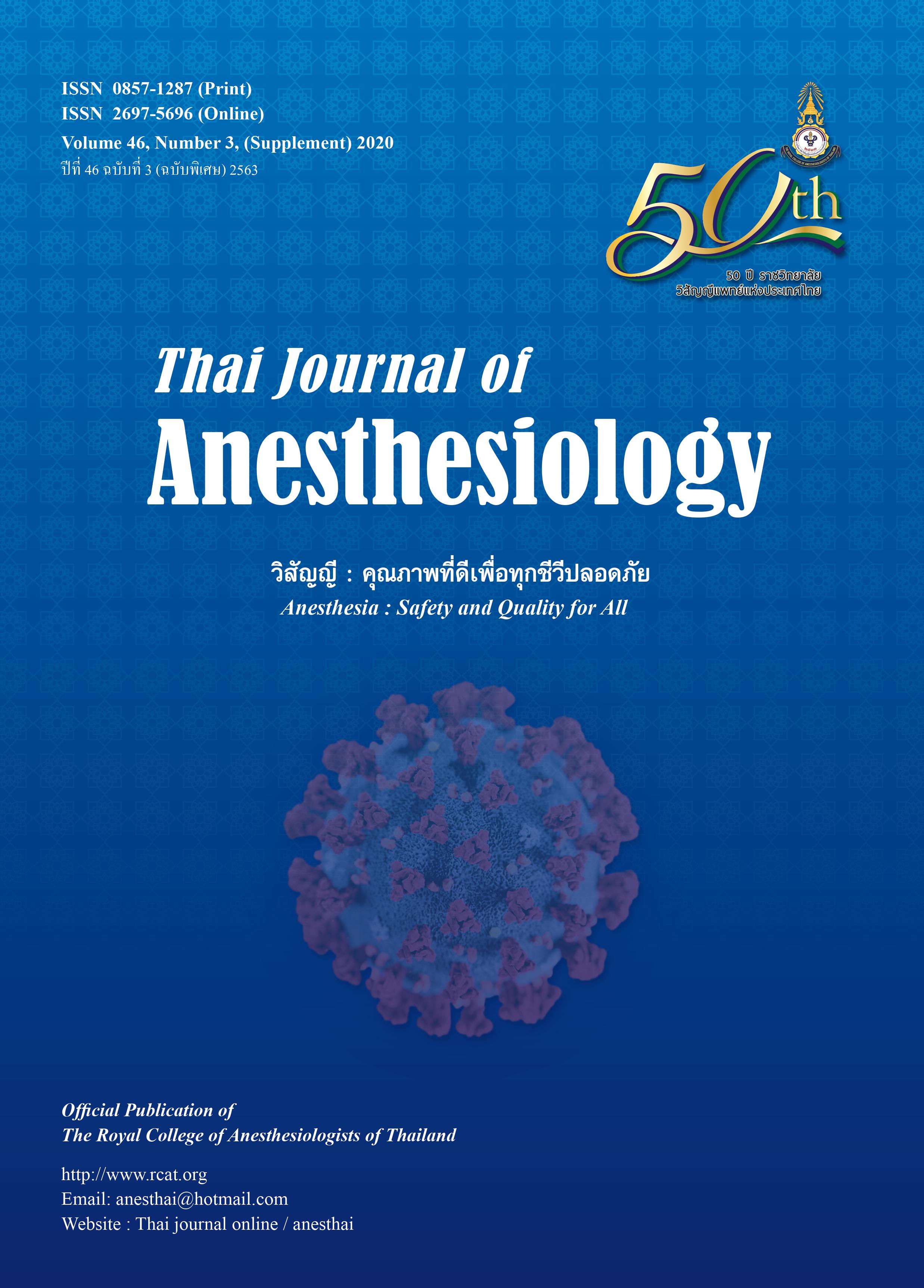Experiences of Tracheal Intubations by Anesthesiologists in Patient with COVID-19
Main Article Content
Abstract
Background: Coronavirus disease 2019; COVID-19 is a
new pandemic disease that may cause respiratory failure.
Endotracheal tube intubation is a crucial procedure for
treatment patients, including patients who need general
anesthesia.
Objective: We collected data about endotracheal tube
intubation in COVID-19 patients who were critically ill or
underwent general anesthesia by anesthesiologists. We
summarized the guidance and problems to improve the
practical guidelines in the future.
Method:A retrospective study of all COVID-19 patients who
were endotracheal tube intubated by anesthesiologists
from 23 March to 19 April 2020 at faculty of Medicine,
Ramathibodi Hospital, Mahidol University.
Result: The total of 8 COVID-19 patients needed
intubation during the study period. Seven patients were
intubated due to acute respiratory failure and 1 patient was
intubated for general anesthesia. Out of 8 patients,
7 patients (87.5%) were male and 1 patient (12.5%) was
female. After intubation, some patients significantly
showed hypotension (25%) and desaturation (50%). The
problems found in our practice were communication,
intravenous drug injection and fit test of personal protective
equipment.
Conclusion: Endotracheal tube intubation in COVID-19
patients is a highly contagious procedure. Hence, cooperation
in all departments, planning, and practicing are keys to
increase rate of success and medical personnel safety
Article Details
References
coronavirus (SARS-CoV-2) based on current evidence. Int J
Antimicrob Agents. 2020 Mar 19. DOI: 10.1016/j.ijantimicag.
2020.105948
2. World Health Organization. Clinical management of severe
acute respiratory infection(SARI) when COVID-19 disease is
suspected [Internet]. 27 May 2020 [cited 29 may 2020.
Available at: https://www.who.int/publications-detail/clinicalmanagement-of-severe-acute-respiratory-infection-whennovel-coronavirus-(ncov)-infection-is-suspected.
3. Tran K, Cimon K, Severn M, Pessoa-Silva CL, Conly J.
Aerosol-generating procedures and risk of transmission of
acute respiratory infections: a systematic review. CADTH
Technology Overviews 2013;3(1) e3101.
4. Orser BA. Recommendations for endotracheal intubation of
COVID-19 patients. Anesth Analg 2020;130:1109-10.
5. Peng PWH, Ho PL, Hota SS. Outbreak of a new coronavirus:
what anaesthetists should know. Br J Anaesth 2020;124:
497-501.
6. Cheung JC, Ho LT, Cheng JV, Cham EYK, Lam KN. Staff
safety during emergency airway management for COVID-19
in Hong Kong. Lancet Respir Med 2020;8:e19.
7. Sehulster L, Chinn RY. Guidelines for environmental infection
control in health-care facilities: recommendations of CDC
and the Healthcare Infection Control Practices Advisory
Committee (HICPAC). MMWR 2003;52(Rr-10):1-42.
8. American Institute of Architects AoAfH, The facility guidelines
institute (with assistance from the U.S. Department of Health
and Human Services). Guidelines for design and construction
of hospital and health care facilities. Washington, DC: AIA
Press; 2001.
9. Wax RS, Christian MD. Practical recommendations for critical
care and anesthesiology teams caring for novel coronavirus
(2019-nCoV) patients. Can J Anaesth 2020;67:568-76.


